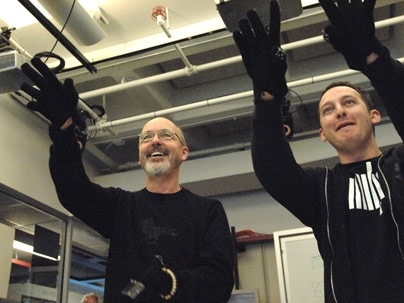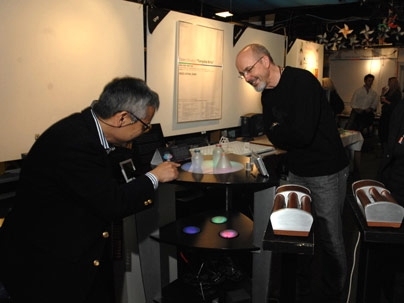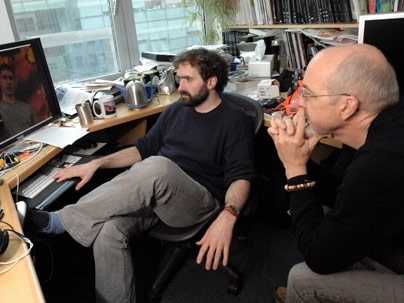More than 35 years ago, Bill Viola jolted the contemporary art world with a new kind of artistic expression: electronic images and sounds that explored themes of love, death and rebirth. Today, the title "video artist" could be claimed by any kid with a camera, but the label rightfully belongs to Viola, who harnessed the potential of high-definition technology to produce evocative and startling snippets of video for museums and installations.
Like many artistic revolutionaries, Viola is now old school. He has exhibited at the Museum of Modern Art, New York, the Guggenheim Museum, New York, and the J. Paul Getty Museum, Los Angeles. In 1997, the Whitney Museum of American Art staged: "Bill Viola: A 25-Year Survey."
His latest honor is the Eugene McDermott Award in the Arts, given by MIT's Council for the Arts, which brings a $75,000 stipend and a chance to spend a week on campus. Which is why, earlier this month, Viola could be seen rushing through the corridors of MIT, wearing a black turtleneck and jeans and carrying a bulging backpack that helped him blend with students and faculty. While admitting he is a self-described "tech head" who delights in new gadgets, Viola used his weeklong residency to both revel in new technologies and rail about its pitfalls. "There is a danger in a place like MIT of having too much head work and not enough heart work," he later explains.
On his first day on campus, the 58-year-old Viola has willingly accepted an agenda that seems wildly overscheduled; he seems anxious to interact with as many people as possible. In the space of a few hours, he plays games at the GAMBIT Lab, talks photography with Frédo Durand, associate professor in the Department of Electrical Engineering and Computer Science, takes a tea break and visits the Tangible Media Group, before dashing off to a Visual Arts Program and dinner with faculty.
In a cramped office, where every surface is covered with lenses, camera bodies and cords, Durand hands Viola a modified lens that can capture different depths of field in one shot. He then shows Viola on a computer how to choose which section of a photo to put in focus. Viola sees the potential immediately: in the future, photographers may not have to make quick decisions about focus, lighting, shadows and other issues during shoots but instead deal with them later while processing photos on their computers.
Durand and Viola discuss the ethics of altering photographs and whether future cameras will become mere "input devices" for computers. Viola's wife and artistic partner, Kira Perov, who is accompanying him, blurts out, "When are we going to take pictures with our eyes?"
Everyone laughs, but Durand takes the question somewhat seriously. "I'm sure it will happen," he says. Viola expresses his worries that technology has allowed photographers to alter images too much. People tend to believe a photograph reflects reality unlike, say, a painting; yet photos may be no more real than any other form of artwork, he says. Still, both he and Durand agree that the popularity of programs like Photoshop have taught the public not to accept all images at face value.
Viola leaves Durand's office reluctantly but is soon engaged by the objects in the Tangible Media Lab and the work of Hiroshi Ishii, the associate director of the Media Lab and the Muriel R. Cooper Professor of Media Arts and Sciences. The lab has created perfume bottles that are "filled" with music. Pulling a stopper out of a bottle triggers a riff of classic music or jazz. "How did you get those musicians into those little bottles?" Viola asks, with only a hint of smile. Actually, the bottles utilize a seemingly invisible interface that Ishii believes could be introduced into household objects. Viola opens another bottle, which is silent -- a glitch, Media Arts and Science graduate student Jamie Zigelbaum explains, adding, "The musicians got out."
Moving to another area, Viola runs his fingers through the fine gravel of what looks like a wired sandbox. This is "SandScape," an interface for designing landscapes through computational simulations. A computer projects contour lines representing wind and shadows onto the sand's surface. As Viola manipulates the sand, the projected lines change, illustrating in a very concrete way how changing a land surface will alter its microclimate. Explains Ishii, "It bridges the gap between the digital world and the physical world." Perov takes a turn digging into the sand. "It's like a Zen garden," she says. "It reminds me of what the Buddha said: 'When foot feels floor, foot feels foot,'" Viola adds.
Viola is pleased at how the lab has turned touch into a computer interface. "I think Hiroshi is on to something extremely powerful," he says. "The average person -- certainly not the people who work here -- has a mistrust of technology. If you can't see it, if you can't touch it, they don't quite believe it, and they don't quite trust it."
By the end of the residency, Viola -- like so many visitors to MIT -- says he has seen the future. But he is not sure all of it works. Once, he says, he was like other MIT students, eager to use the latest imaging technology. "Now, I tend to talk a lot less about technology and a lot more about the use of that technology, which ultimately is about human moral, ethical and spiritual decisions."
A version of this article appeared in MIT Tech Talk on April 1, 2009 (download PDF).








